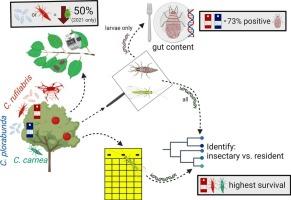辅助放养草蛉防治苹果蚜虫的研究
IF 3.4
2区 农林科学
Q2 BIOTECHNOLOGY & APPLIED MICROBIOLOGY
引用次数: 0
摘要
在华盛顿州(美国)的苹果生产中,越来越多地采用商业饲养的草蛉来管理蚜虫,这可能是由于有机种植面积的扩大和缺乏有效的化学选择。为了解决该作物缺乏以研究为基础的最佳实践建议的问题,我们比较了不同草蛉(Chrysoperla rufilabris, C. plor丰a, C. carnea)的释放,生命阶段(卵与幼虫)和释放方法(手工喷洒,卵卡,无人机分散)对蚜虫的抑制和草蛉的存活率。使用通用引物和物种特异性引物,通过分子肠道含量分析检查了田间害虫和野生猎物的消耗情况。2021年,与对照相比,单手释放plorabunda C.卵或C. rufilabris幼虫使蚜虫数量减少了50%,但释放C. carnea幼虫或C. rufilabris卵没有减少蚜虫数量。在2022-2023年,所有释放处理都没有降低蚜虫的丰度,可能是因为初始蚜虫数量要高得多。2023年释放的草蛉的回收率也很低,可能是由于农药的使用。草蛉幼虫重捕率以卵卡和手放处理最高;从这些处理中重新捕获的幼虫也更频繁地被检测出害虫蚜虫DNA阳性。我们没有发现草蛉幼虫吞食其他果园捕食者的证据。我们的初步结果表明,除草可以显著降低蚜虫的丰度,但释放效果高度依赖于释放方法、生命阶段和时间。在第一次出现蚜虫的迹象时尽早释放似乎对成功特别关键。本文章由计算机程序翻译,如有差异,请以英文原文为准。

Augmentative releases of insectary-reared lacewings for aphid control in apples
In Washington State (U.S.) apple production, adoption of augmentative releases of commercially-reared lacewings for aphid management is increasing, likely due to expanding organic acreage and a lack of effective chemical options. To address the lack of research-based best practice recommendations for this crop, we compared releases of different lacewing species (Chrysoperla rufilabris, C. plorabunda, C. carnea), life stages (eggs versus larvae), and release methods (sprinkling by hand, egg cards, drone dispersal) for aphid suppression and lacewing survival. Pest and intraguild prey consumption in the field was examined with molecular gut content analysis, using both universal and species-specific primers. In 2021, one hand release of C. plorabunda eggs or C. rufilabris larvae reduced aphid populations by ∼50 % compared to the control, but a release of C. carnea larvae or C. rufilabris eggs did not. In 2022–2023, none of the release treatments decreased aphid abundance, likely because initial aphid numbers were much higher. Recovery of released lacewings was also low in 2023, potentially due to pesticide applications. The highest lacewing larvae recapture rates occurred in the egg card and hand-released larvae treatments; larvae recaptured from these treatments also more frequently tested positive for pest aphid DNA. We found no evidence that lacewing larvae consume other orchard predators. Our initial results indicate that lacewing releases may substantially reduce aphid abundance, but release efficacy is highly dependent on release method, life stage, and timing. Early season releases at the first sign of aphids appear to be particularly critical for success.
求助全文
通过发布文献求助,成功后即可免费获取论文全文。
去求助
来源期刊

Biological Control
生物-昆虫学
CiteScore
7.40
自引率
7.10%
发文量
220
审稿时长
63 days
期刊介绍:
Biological control is an environmentally sound and effective means of reducing or mitigating pests and pest effects through the use of natural enemies. The aim of Biological Control is to promote this science and technology through publication of original research articles and reviews of research and theory. The journal devotes a section to reports on biotechnologies dealing with the elucidation and use of genes or gene products for the enhancement of biological control agents.
The journal encompasses biological control of viral, microbial, nematode, insect, mite, weed, and vertebrate pests in agriculture, aquatic, forest, natural resource, stored product, and urban environments. Biological control of arthropod pests of human and domestic animals is also included. Ecological, molecular, and biotechnological approaches to the understanding of biological control are welcome.
 求助内容:
求助内容: 应助结果提醒方式:
应助结果提醒方式:


